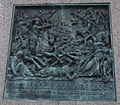Battle of Heliopolis (1800)
This article needs additional citations for verification. (November 2015) |
| Battle of Heliopolis | |||||||
|---|---|---|---|---|---|---|---|
| Part of the Egypt-Syria Campaign | |||||||
 Bataille d'Héliopolis, by Leon Cogniet | |||||||
| |||||||
| Belligerents | |||||||
|
|
| ||||||
| Commanders and leaders | |||||||
|
|
| ||||||
| Strength | |||||||
| 10,000 men[2] | 60,000 men[3] | ||||||
| Casualties and losses | |||||||
| 600 dead or wounded | 8,000-9,000 dead, wounded or captured | ||||||
The Battle of Heliopolis was an engagement that pitted the French Armée d'Orient under General Kléber against a British-supported Ottoman army at Heliopolis[4] on 20 March 1800.
Background[]
Kléber engaged in negotiations with both the British and Ottomans, with the aim of honourably evacuating the remains of the French force from Egypt to take part in operations in Europe. An accord (the Convention of El Arish) was concluded on 23 January 1800 allowing such a return to France, but it proved impossible to apply due to internal dissensions among the British and the dithering of the Sultan, and so the conflict in Egypt restarted.
Kléber was betrayed by the British Admiral Keith, who did not respect the El Arich convention. He therefore restarted hostilities, for he refused to surrender. The British and the Ottomans believed the armée d'Orient was now too weak to resist them, and so Yussuf Pasha marched on Cairo, where the local population obeyed his call to revolt against French rule.
Battle[]
The French advanced to Mataria, where they arrived on the morning of March 20 at 3 p.m. The French organized themselves into four square formations. The corners of the squares had artillery and grenadiers. The left wing of the French was commanded by General Jean Reynier and the right wing by General Louis Friant. Kléber commanded the center of the forces and General Charles Leclerc the French cavalry in the center of the forces.
Reynier's left wing struck directly against Mataria's Janissaries as Friant cut off their retreat route. The French cavalry, in turn, clashed with the Ottoman cavalry. In addition to the Turks, the Ottoman side had Mamluk cavalry. The Janissaries were defeated relatively quickly and the French began to move towards the main Ottoman forces in the direction of Heliopolis. In Heliopolis, the Ottomans were led by Yussuf Pasha. The Ottomans launched an attack on the French, which proved disorganized. The attack caught fire with the French cannon fire and turned into an uncontrollable retreat. Eventually, the French also reached the Ottoman camp. The Ottoman army fled to Syria.
Consequences[]
The losses of the French in the battle of Heliopolis remained very small. There were only about 600 French casualties. There were about 8,000 casualties on the Ottoman side. Kléber had managed to save the seemingly desperate situation, at least for the time being. He was also able to quell the uprising that erupted in Cairo. The position of the French was further strengthened with Kléber's recruitment of local auxiliaries and his alliance with his former enemy Murad Bey. However, Kléber was assassinated later that year and his successor, Jacques-François de Menouta, was considered a much weaker leader.
Gallery[]

Le général Kléber victorieux à Héliopolis, 20 mars 1800, by Philippe Grass. Public sculpture at Place Kléber, Strasbourg.
References[]
- ^ Tucker, Spencer C. (23 December 2009). A Global Chronology of Conflict: From the Ancient World to the Modern Middle East [6 volumes]: From the Ancient World to the Modern Middle East. ABC-CLIO. p. 1021. ISBN 978-1-85109-672-5.
- ^ Tucker, Spencer C. (23 December 2009). A Global Chronology of Conflict: From the Ancient World to the Modern Middle East [6 volumes]: From the Ancient World to the Modern Middle East. ABC-CLIO. p. 1021. ISBN 978-1-85109-672-5.
- ^ Tucker, Spencer C. (23 December 2009). A Global Chronology of Conflict: From the Ancient World to the Modern Middle East [6 volumes]: From the Ancient World to the Modern Middle East. ABC-CLIO. p. 1021. ISBN 978-1-85109-672-5.
- ^ Charles River Editors (2018). Napoleon in Egypt: The History and Legacy of the French Campaign in Egypt and Syria. Charles River Editors. ISBN 978-1718863620.
{{cite book}}:|last=has generic name (help)
Sources[]
- Alexandre Tchoudinov, La bataille d’Héliopolis, ou la victoire oubliée in Napoleonica, Fondation Napoléon, n 3, 2015, pp. 5–47.
- 1800 in Egypt
- 1800 in the Ottoman Empire
- Battles involving the Ottoman Empire
- Battles involving France
- Battles of the French Revolutionary Wars
- Conflicts in 1800
- French campaign in Egypt and Syria
- Battles inscribed on the Arc de Triomphe
- French battle stubs

